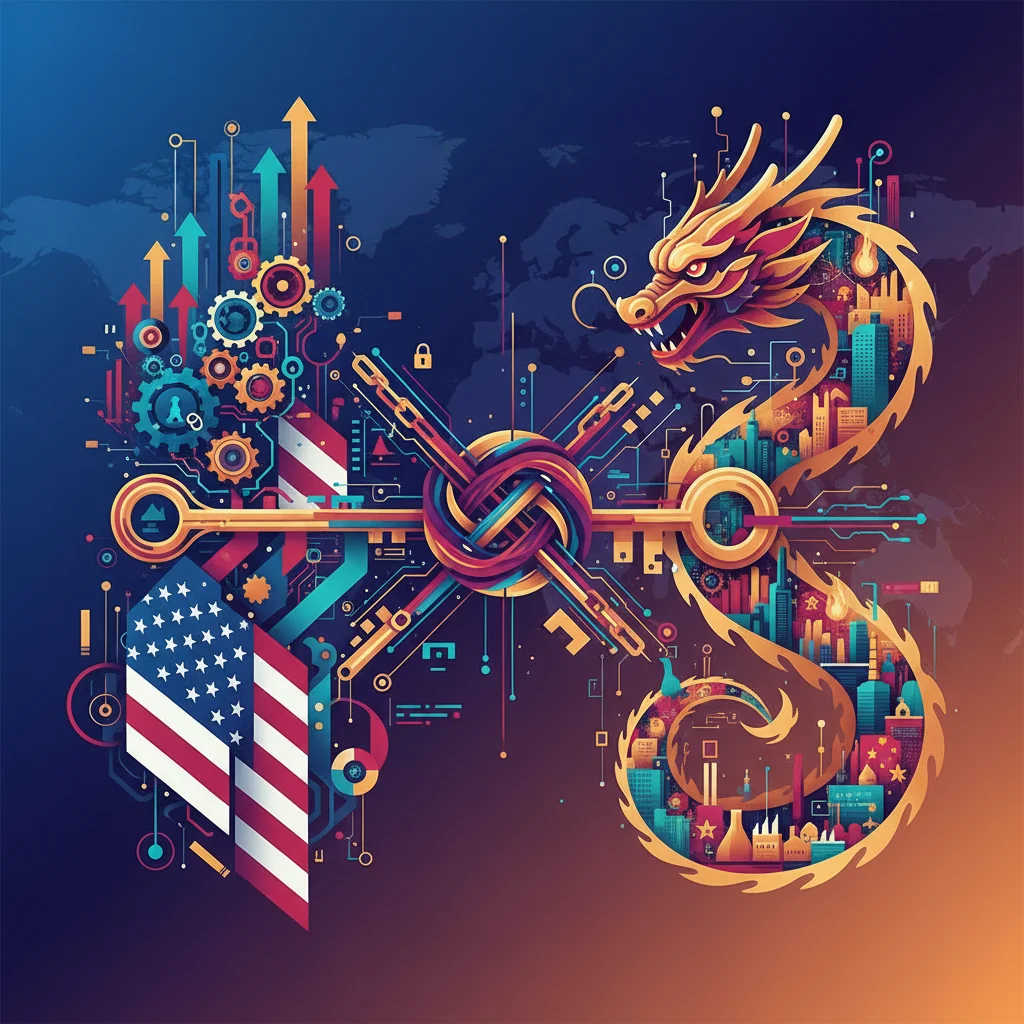
The China Conundrum: Why US Businesses Can’t Quit the World’s Largest Market
In the grand theater of global economics, the relationship between the United States and China is the headline act—a complex drama filled with political tension, technological rivalry, and sharp-tongued rhetoric. From Washington’s perspective, the narrative is one of “de-risking” and strategic competition. Yet, on the ground in Shanghai, a different story is unfolding. At a recent major trade fair, American exporters weren’t just present; they were actively and enthusiastically courting the very market their government views with such caution. This striking paradox reveals a fundamental truth: for many businesses, the gravitational pull of the Chinese consumer is simply too powerful to ignore.
This isn’t just about selling a few more widgets. It’s a high-stakes strategic play that has profound implications for the global economy, international finance, and the future of corporate investing. While political leaders talk of decoupling, business leaders are busy coupling their futures to a market of 1.4 billion people. This post will delve into the economic realities driving this trend, analyze the intricate dance between commerce and geopolitics, and explore what it means for investors, business leaders, and the future of global trade.
The Irresistible Allure: A Market Too Big to Ignore
To understand the corporate mindset, one must first grasp the sheer scale of the opportunity. China is not just another country; it is a continental-sized consumer market with a rapidly expanding middle class. As one American agricultural exporter at the Shanghai fair noted, “We have to come here… the market is here.” This sentiment was echoed across the exhibition hall, where companies from California wine producers to Texan beef ranchers showcased their goods.
The numbers paint a clear picture. Despite tariffs and political headwinds, the US-China trade relationship remains one of the world’s most significant. In 2022, US goods and services trade with China totaled an estimated $758.4 billion. The “Phase One” trade deal, signed under the Trump administration, aimed to rebalance this relationship by committing China to purchase an additional $200 billion in US goods and services. While China ultimately fell short of these ambitious targets, the deal signaled a framework for continued, albeit managed, commercial engagement. For companies on the ground, any framework is better than none, providing a semblance of stability in a turbulent environment.
For many global brands, China is no longer just a growth market; it’s a primary driver of revenue and a crucial indicator for the stock market. A strong quarter in China can send a company’s stock soaring, while a slump can trigger a sell-off. This deep integration makes a full “decoupling” a financial impossibility for many publicly traded firms.
UK's £420M Lifeline for Heavy Industry: A Strategic Investment or a Drop in the Ocean?
Navigating the Labyrinth: Geopolitics vs. Profit Motives
The decision to double down on China is not made in a vacuum. Executives are keenly aware of the risks, which are both numerous and complex. These include regulatory uncertainty, intellectual property theft, and the ever-present danger of becoming a pawn in a larger geopolitical chess match. The current strategy for many multinationals is not decoupling, but “de-risking”—a nuanced approach that involves diversifying supply chains (“China plus one” strategy) while simultaneously deepening their presence within the Chinese market to serve Chinese consumers.
This dual strategy creates a fascinating dynamic. A company might move its export-oriented manufacturing to Vietnam or Mexico to circumvent tariffs and supply chain vulnerabilities, while at the same time investing heavily in marketing, distribution, and R&D *inside* China to capture local market share. It’s a sophisticated balancing act that requires immense capital, strategic foresight, and a high tolerance for risk.
To illustrate the opportunities and challenges, consider the following breakdown for businesses looking to enter or expand in China:
| Key Sectors of Opportunity | Associated Challenges & Risks |
|---|---|
| Agriculture & Food Products: High demand for quality foreign goods like beef, wine, and nuts. | Subject to sudden tariffs, politically motivated boycotts, and complex food safety regulations. |
| Luxury Goods & Consumer Brands: A massive and aspirational middle class drives strong sales. | Fierce competition from domestic brands, rapidly changing consumer tastes, and sensitivity to economic downturns. |
| Healthcare & Pharmaceuticals: An aging population and increasing wealth create huge demand. | Strict regulatory hurdles, lengthy approval processes, and pressure to lower prices from the state. |
| Financial Services & Fintech: A gradually opening market with immense potential for growth. | Heavy state control, data security laws, and dominance of local tech giants like Alipay and WeChat Pay. |
The Role of Finance and Technology in Bridging the Divide
This intricate dance of global trade is impossible without a sophisticated financial infrastructure operating in the background. International banking is the circulatory system, facilitating the massive capital flows required for trade and investment. Every container of American soybeans or iPhones shipped to China is underpinned by complex financial instruments like letters of credit, trade financing, and currency hedging.
This is where financial technology (fintech) is becoming a game-changer. Cross-border payments, historically slow and expensive, are being streamlined by fintech platforms that offer faster, cheaper, and more transparent transactions. For small and medium-sized exporters, this innovation is critical, lowering the barrier to entry into challenging markets like China. Furthermore, advancements in supply chain finance are allowing businesses to unlock capital tied up in inventory and receivables, improving cash flow and reducing risk.
Looking ahead, emerging technologies like blockchain hold the potential to revolutionize this space. By creating a transparent, immutable ledger, blockchain could track goods from farm to table or factory to consumer, enhancing trust and efficiency. In a trade relationship often plagued by disputes over product origin and intellectual property, this could be a transformative development. The evolution of this financial and technological plumbing is a key area of economics to watch, as it will determine the pace and scale of future global trade.
The Hidden Capital in Your Utility Bill: Unlocking Dormant Assets in a Digital Economy
An Investor’s Guide to the China Conundrum
For those involved in investing and trading, the situation presents both tantalizing opportunities and significant perils. How does one approach a market that offers immense growth potential but is also subject to the whims of geopolitical forces?
The Bull Case:
- Unmatched Growth: No other market offers the same potential for scale and growth in consumer spending. Companies that successfully penetrate the Chinese market can see their revenues and profits supercharged.
- Innovation Hub: China is no longer just a manufacturing base; it is a center for innovation in areas like e-commerce, digital payments, and electric vehicles. Foreign companies can benefit from and contribute to this dynamic ecosystem.
- Diversification: For US-centric companies, a strong presence in China provides geographic diversification, reducing reliance on the domestic market.
The Bear Case:
- Geopolitical Volatility: A flare-up over Taiwan or a new round of tariffs could instantly damage business operations and investor sentiment. As one US business lobbyist in China mentioned, there’s a constant fear that “politics is going to make it impossible to do business here.” (source)
- Regulatory Risk: Beijing’s regulatory crackdowns can occur swiftly and with little warning, impacting entire industries from tech to private education.
- Economic Headwinds: China’s economy faces its own internal challenges, including a property market crisis, high youth unemployment, and demographic pressures.
A prudent investment strategy involves looking beyond the headlines. Analyze companies based on their specific exposure and strategy. Does the company have a “in China, for China” model that insulates it from trade disputes? How resilient is its supply chain? Does management have a proven track record of navigating complex regulatory environments? These are the questions that separate savvy investors from those caught off guard by the next political tremor.
Beyond the Bus Stop: Analyzing the Economic Fallout of the UK's Youth Transport Decision
Conclusion: The Enduring Power of Economic Gravity
The scene at the Shanghai trade fair is a powerful reminder that global commerce often operates on a different frequency than international politics. While governments build walls, businesses build bridges—not out of idealism, but out of economic necessity. The US-China relationship will continue to be a defining feature of the 21st-century global landscape, characterized by a perpetual push and pull between competition and codependence.
For business leaders and investors, the key is not to predict the political future but to build strategies that are resilient to it. The allure of the Chinese market is a force of economic gravity, and despite the risks, American businesses are demonstrating that they are not yet ready—or willing—to defy it.


